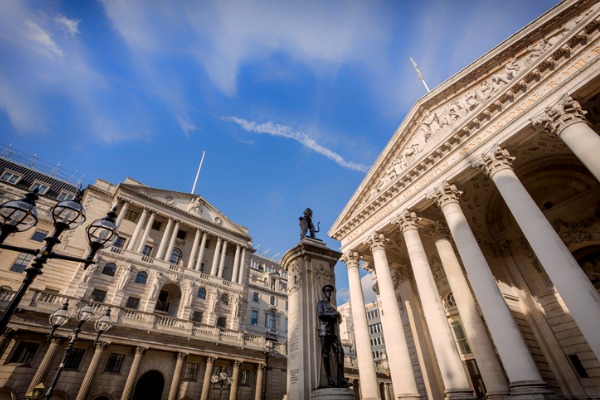UK interest rates tipped to hit 4% after new jobs data
13th September 2022 13:47
by Graeme Evans from interactive investor
Government help with energy bills and tax cuts may put more money in your pocket, but there will be longer-term inflation consequences.

Three more half-point increases in interest rates have been forecast for this year as a tight labour market caused by worker shortages adds to pressure on the Bank of England.
Today’s surprise fall in the jobless rate to 3.6% in the three months to July reinforces the case among Bank of England “hawks” for a back-to-back 0.5% increase on Thursday next week.
- Read about how to: Open a Trading Account | How to start Trading Stocks | Top UK shares
The prospect of a further aggressive tightening in monetary policy ended the respite for retail stocks, having been lifted recently by a fall in natural gas prices and some clarity on the consumer demand outlook thanks to energy cap initiatives in Europe.
Next (LSE:NXT) shares, for example, rallied more than 6% between Thursday afternoon and yesterday but fell back 53p to 6,011p today. Homewares chain Dunelm Group (LSE:DNLM) lost 15.5p to 747.5p.
The next week or so promises to be hugely significant for determining the likely direction of stock markets over the rest of the year, with the Federal Reserve widely expected to announce another half-point increase in rates on Wednesday next week.
The UK interest rate is currently at 1.75% following a 0.5% rise at the August meeting when the Bank’s forecasts pointed to inflation peaking at 13% this year due to energy bill hikes.
The support measures announced by new prime minister Liz Truss should trim at least two percentage points from inflation in the fourth quarter, reducing some of the pressure on policymakers to consider a 0.75% interest rate hike next week.
But the support for bills, as well as tax cuts and higher defence spending in a forthcoming emergency budget due in a week’s time, have longer-term inflation consequences.
- 10.1% inflation shock: what it means for your retirement
- Shares to protect against persistently high inflation
Bank of America said: “By lowering peak inflation we see the government's energy price cap allowing the BoE to avoid increasing the pace of hikes. But more fiscal stimulus means the BoE will have to hike more overall. Looser fiscal means tighter monetary (policy).”
The US bank sees half-point hikes in September, November and December before 0.25% rises in February, May and August next year. Its new peak is now at 4% compared with 3.25% before the fiscal stimulus, with no rate cuts expected before the end of 2024.
The Bank of America analysis points to seven policymakers next week voting in favour of a 0.5% increase, with the remaining two members supporting either a 0.25% or 0.75% hike.
Lowest unemployment rate since 1974
The ongoing tightness in the labour market following today’s fall in the jobless rate from 3.8% previously will have done little to ease the pressure for further tightening.
The lowest unemployment rate since 1974 was driven not by an increase in the number of people in employment, but by another rise in those classified as inactive – that is neither in work nor actively seeking it.
Demand for employees appears to be cooling as the level of job vacancies has fallen from its high, but the number of redundancies is low and stable. The question now for City economists is whether the pressure from energy prices will force companies to revise their staffing plans.
For now, ING economist James Smith thinks persistent worker supply constraints coupled with only modest signs of reduced hiring demand will provide further ammunition for the Bank of England hawks.
Smith expects a half point rate hike next week, and another in November. He added: “While markets may be overestimating how far the Bank will take interest rates over the coming months, we think the Bank is less likely to be cutting rates early into 2023 than some other global central banks.”
Ruth Gregory, senior UK economist at Capital Economics, also expects a 0.5% increase next week, noting that there have been few signs of a slowing in the upward momentum on wage growth.
The rate excluding bonuses accelerated from 4.7% to 5.2% in the July quarter, stronger than the consensus forecast of 5% and well above the rates of 3%-3.5% that are consistent with the Bank of England’s 2% inflation target.
Gregory added: “With the supply of workers set to remain unusually low for a couple of years yet, we think that the Bank will raise interest rates from 1.75% to 2.25% on 22 September and to a peak of 3% or higher.”
These articles are provided for information purposes only. Occasionally, an opinion about whether to buy or sell a specific investment may be provided by third parties. The content is not intended to be a personal recommendation to buy or sell any financial instrument or product, or to adopt any investment strategy as it is not provided based on an assessment of your investing knowledge and experience, your financial situation or your investment objectives. The value of your investments, and the income derived from them, may go down as well as up. You may not get back all the money that you invest. The investments referred to in this article may not be suitable for all investors, and if in doubt, an investor should seek advice from a qualified investment adviser.
Full performance can be found on the company or index summary page on the interactive investor website. Simply click on the company's or index name highlighted in the article.